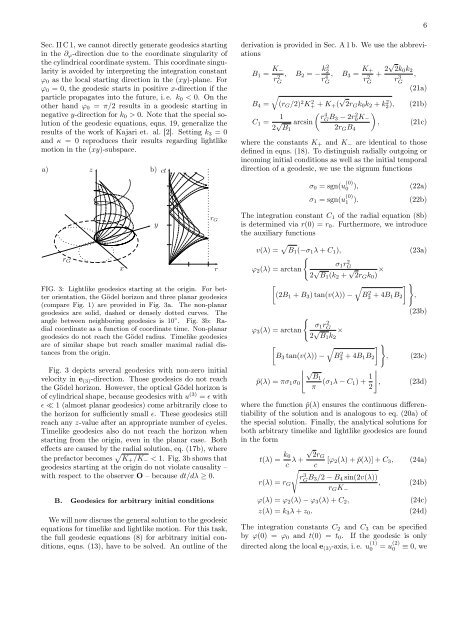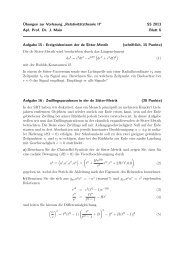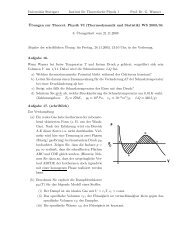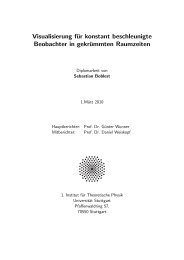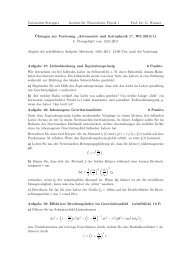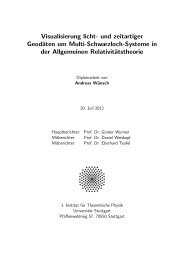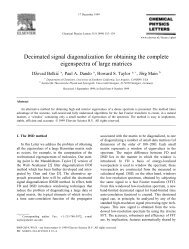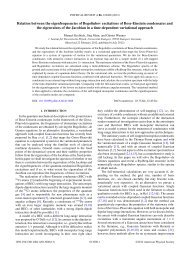The Gödel universe - Institut für Theoretische Physik der Universität ...
The Gödel universe - Institut für Theoretische Physik der Universität ...
The Gödel universe - Institut für Theoretische Physik der Universität ...
Create successful ePaper yourself
Turn your PDF publications into a flip-book with our unique Google optimized e-Paper software.
Sec. II C1, we cannot directly generate geodesics starting<br />
in the ∂ϕ-direction due to the coordinate singularity of<br />
the cylindrical coordinate system. This coordinate singularity<br />
is avoided by interpreting the integration constant<br />
ϕ0 as the local starting direction in the (xy)-plane. For<br />
ϕ0 = 0, the geodesic starts in positive x-direction if the<br />
particle propagates into the future, i.e. k0 < 0. On the<br />
other hand ϕ0 = π/2 results in a geodesic starting in<br />
negative y-direction for k0 > 0. Note that the special solution<br />
of the geodesic equations, eqns. 19, generalize the<br />
results of the work of Kajari et. al. [2]. Setting k3 = 0<br />
and κ = 0 reproduces their results regarding lightlike<br />
motion in the (xy)-subspace.<br />
a) z<br />
b) ct<br />
rG<br />
x<br />
FIG. 3: Lightlike geodesics starting at the origin. For better<br />
orientation, the <strong>Gödel</strong> horizon and three planar geodesics<br />
(compare Fig. 1) are provided in Fig. 3a. <strong>The</strong> non-planar<br />
geodesics are solid, dashed or densely dotted curves. <strong>The</strong><br />
angle between neighboring geodesics is 10 ◦ . Fig. 3b: Radial<br />
coordinate as a function of coordinate time. Non-planar<br />
geodesics do not reach the <strong>Gödel</strong> radius. Timelike geodesics<br />
are of similar shape but reach smaller maximal radial distances<br />
from the origin.<br />
Fig. 3 depicts several geodesics with non-zero initial<br />
velocity in e (3)-direction. Those geodesics do not reach<br />
the <strong>Gödel</strong> horizon. However, the optical <strong>Gödel</strong> horizon is<br />
of cylindrical shape, because geodesics with u (3) = ǫ with<br />
ǫ ≪ 1 (almost planar geodesics) come arbitrarily close to<br />
the horizon for sufficiently small ǫ. <strong>The</strong>se geodesics still<br />
reach any z-value after an appropriate number of cycles.<br />
Timelike geodesics also do not reach the horizon when<br />
starting from the origin, even in the planar case. Both<br />
effects are caused by the radial solution, eq. (17b), where<br />
the prefactor becomes K+/K− < 1. Fig. 3b shows that<br />
geodesics starting at the origin do not violate causality –<br />
with respect to the observer O – because dt/dλ ≥ 0.<br />
B. Geodesics for arbitrary initial conditions<br />
We will now discuss the general solution to the geodesic<br />
equations for timelike and lightlike motion. For this task,<br />
the full geodesic equations (8) for arbitrary initial conditions,<br />
eqns. (13), have to be solved. An outline of the<br />
y<br />
rG<br />
r<br />
<strong>der</strong>ivation is provided in Sec. A1b. We use the abbreviations<br />
B1 = K−<br />
r2 , B2 = −<br />
G<br />
k2 2<br />
r4 , B3 =<br />
G<br />
K+<br />
r2 +<br />
G<br />
2√2k0k2 r3 ,<br />
G<br />
(21a)<br />
<br />
B4 = (rG/2) 2K2 + + K+( √ 2rGk0k2 + k2 2 ), (21b)<br />
C1 = 1<br />
2 √ 4 rGB3 − 2r<br />
arcsin<br />
B1<br />
2 <br />
0K−<br />
, (21c)<br />
2rGB4<br />
where the constants K+ and K− are identical to those<br />
defined in eqns. (18). To distinguish radially outgoing or<br />
incoming initial conditions as well as the initial temporal<br />
direction of a geodesic, we use the signum functions<br />
6<br />
σ0 = sgn(u (0)<br />
0 ), (22a)<br />
σ1 = sgn(u (0)<br />
1 ). (22b)<br />
<strong>The</strong> integration constant C1 of the radial equation (8b)<br />
is determined via r(0) = r0. Furthermore, we introduce<br />
the auxiliary functions<br />
v(λ) = B1(−σ1λ + C1),<br />
<br />
σ1r<br />
ϕ2(λ) = arctan<br />
(23a)<br />
2 G<br />
2 √ B1(k2 + √ 2rGk0) ×<br />
<br />
<br />
(2B1 + B3)tan(v(λ)) − B2 <br />
3 + 4B1B2<br />
<br />
,<br />
<br />
σ1r 2 G<br />
(23b)<br />
ϕ3(λ) = arctan<br />
2 √ <br />
×<br />
B1k2<br />
<br />
B3 tan(v(λ)) − B2 <br />
3 + 4B1B2<br />
<br />
, (23c)<br />
˜p(λ) = πσ1σ0<br />
√B1 π (σ1λ − C1) + 1<br />
<br />
, (23d)<br />
2<br />
where the function ˜p(λ) ensures the continuous differentiability<br />
of the solution and is analogous to eq. (20a) of<br />
the special solution. Finally, the analytical solutions for<br />
both arbitrary timelike and lightlike geodesics are found<br />
in the form<br />
t(λ) = k0<br />
√<br />
2rG<br />
λ + [ϕ2(λ) + ˜p(λ)] + C3, (24a)<br />
c<br />
<br />
c<br />
r<br />
r(λ) = rG<br />
3 GB3/2 − B4 sin(2v(λ))<br />
, (24b)<br />
rGK−<br />
ϕ(λ) = ϕ2(λ) − ϕ3(λ) + C2, (24c)<br />
z(λ) = k3λ + z0. (24d)<br />
<strong>The</strong> integration constants C2 and C3 can be specified<br />
by ϕ(0) = ϕ0 and t(0) = t0. If the geodesic is only<br />
directed along the local e (3)-axis, i.e. u (1)<br />
0 = u(2) 0 ≡ 0, we


